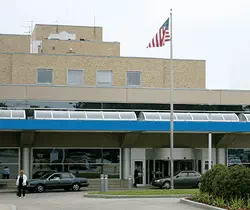 |
||||||||||||||||||||||||||||||||||||||||||||||||||||||||||
|
||||||||||||||||||||||||||||||||||||||||||||||||||||||||||
Please note: Your facility may be covered by state and local regulations that may involve additional requirements or more stringent standards than the federal standards summarized here. EPA has compiled a list of state air pollution agency contacts as part of a recent effort to develop National Emissions Standards for Hazardous Air Pollutants (NESHAP) rules for boilers. This list is not comprehensive or updated, but may help you locate further information for your state. In general, to minimize adverse environmental impacts and ensure operator safety, boilers must be operated and maintained by trained staff in accordance with the manufacturers' specifications. In addition, there are a number of federal standards and regulations that apply to boiler operations. The rest of this section contains a summary of the applicable rules. |
| Citation | Applicability | Pollutants Addressed |
| 40 CFR Part 60 subpart Db |
|
|
| 40 CFR part 60 subpart Dc |
|
|
| 40 CFR Part 60 Subpart A | Note that if an NSPS standard applies, facilities must comply with the NSPS General Provisions in Subpart A |
National Emission Standards for Hazardous Air Pollutants
Boilers. Boilers at medical facilities that are major sources for Hazardous Air Pollutants under the Clean Air Act (potential to emit 10 tons/yr of a HAP or 25 tons/yr of a combination of HAPs) may be subject to the Industrial, Commercial and Institutional boilers and process heaters standard, if another NESHAP standard doesn't already apply. Facilities that are part of a larger entity, such as a university, prison or military base would be the most likely facilities to be major HAP sources under the CAA .
| Citation | Applicability | Regulated Pollutants |
40 CFR
63 |
|
|
| 40 CFR Part 63 Subpart A | Note that if an NESHAP standard applies, facilities must comply with the NESHAP General Provisions in Subpart A |
More information, including an explanatory brochure, applicability flowchart and rule language, is available from the boiler NESHAP development page on the EPA website.
Boilers that burn alternative fuels other than fossil fuels, including solid waste, may be subject to additional combustion regulations.
Boilers and Industrial Furnaces (BIF) that use or burn fuel containing hazardous waste must comply with design and operating standards. BIF regulations (40 CFR part 266, Subpart H) address unit design, provide performance standards, require emissions monitoring, and in some cases, restrict the type of waste that may be burned.
Asbestos
Any facility that contains asbestos, often used in insulation for boilers and pipes, is subject to the Asbestos National Emission Standard for Hazardous Air Pollutants (NESHAP). The Demolition and Renovation standard stipulates EPA notification and proper handling and disposal when asbestos containing material is disturbed.
Title V of the Clean Air Act mandates that states compile all applicable standards, such as those that apply to boilers, into a single permit for each major source.
Find more information on asbestos on the Asbestos page, and find information for your state on the Asbestos State Regulation Locator.
NOx SIP Call
On September 24, 1998, EPA finalized a "Finding of Significant Contribution and Rulemaking for Certain States in the Ozone Transport Assessment Group Region for Purposes of Reducing Regional Transport of Ozone" (commonly known as the "NOx SIP Call") requiring 22 States and the District of Columbia to submit State implementation plans that address the regional transport of ground-level ozone. The rule requires emission reduction measures to be in place by May 1, 2003. These measures will include controls on ozone precursors, such as NOx, emitted by fossil fuel-fired boilers and power generation units.
Boilers with a rated capacity over 250 million BTUs that are located in the eastern half of the US should be in contact with their state permitting agencies to see how this may apply.
More information is available on an information page on the NOx SIP Call provided by EPA.
Water used to maintain boilers, which can contain contaminants like those listed below, must be managed in accordance with the facility's pretreatment program if, as in most cases, the facility discharges to a Publicly Owned Treatment Works. Likewise, if the facility is a direct discharger the effluent standards for contaminants would be addressed in the CWA National Pollutant Discharge Elimination System (NPDES) permit.
Waste Streams and Effluent Limitations
| Waste Stream | BAT Effluent Limitation Guidelines |
| All discharges | pH, poly-chlorinated biphenyls (PCBs) |
| Bottom ash transport waters and low volume waste sources | TSS, oil and grease |
| Chemical boiler metal cleaning wastes | TSS, oil and grease, iron, copper |
| Non-chemical metal cleaning wastes | Reserved (low volume wastewater limits apply) |
| Fly ash transport water (including economizer ash) | No discharge allowed (based on availability of dry disposal methods and the potential for reuse of fly ash transport water) |
| Once-through cooling water | Total residual chlorine (TRC) of free available chlorine (FAC), depending on facility's generating capacity |
| Cooling water blowdown | FAC, chromium, zinc, other 126 priority pollutants where they are found in chemicals used for cooling tower maintenance |
| Coal pile runoff | TSS |
Ash from boilers fueled strictly by oil and coal may be subject to disposal requirements at the state level. It is not regulated as hazardous waste at the federal level.
Note that oil combustion wastes managed in unlined settling basins may pose potential ground-water pathway risks for three pollutants: arsenic, nickel, and vanadium. EPA determined, however, that oil combustion wastes do not warrant regulation as hazardous wastes under RCRA Subtitle C (65 Federal Register 32213, May 22, 2000).
The EPA Air Toxics website provides a convenient index page for all combustion-related rules.
 Boilers
Boilers